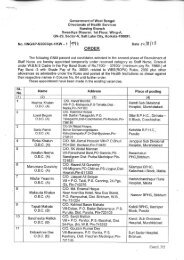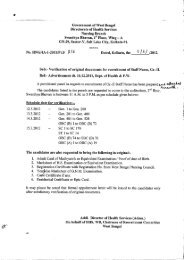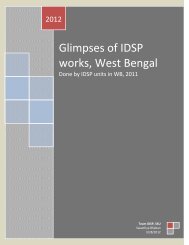Annual Administrative Report 2010-11 - Department of Health ...
Annual Administrative Report 2010-11 - Department of Health ...
Annual Administrative Report 2010-11 - Department of Health ...
- No tags were found...
Create successful ePaper yourself
Turn your PDF publications into a flip-book with our unique Google optimized e-Paper software.
ANNUALreport20<strong>11</strong>Institute <strong>of</strong> <strong>Health</strong> and Family Welfare<strong>Department</strong> <strong>of</strong> <strong>Health</strong> and Family WelfareGovernment <strong>of</strong> West Bengal
From the Director’s DeskThe Institute <strong>of</strong> <strong>Health</strong> and Family Welfare (IHFW) is the training wing <strong>of</strong> the <strong>Department</strong> <strong>of</strong><strong>Health</strong> and Family Welfare, Government <strong>of</strong> West Bengal. IHFW carries out its activities with aview to improve the knowledge and skill <strong>of</strong> the providers through conducting different kinds <strong>of</strong>health related trainings, in situ and in identified training centers since 1995. The institute is inthe process <strong>of</strong> bringing out its first annual report titled “<strong>Annual</strong> <strong>Report</strong> 20<strong>11</strong>”. This is the firsteffort, ever made, in this direction and reflects its activities in brief, since its inception.The IHFW has a mandate to improve the total effectiveness <strong>of</strong> health care delivery by impartingknowledge and technical skills at different levels. IHFW has been identified as a CollaboratingTraining Institute between the <strong>Department</strong>, National Institute <strong>of</strong> <strong>Health</strong> and Family Welfare,and the Ministry <strong>of</strong> <strong>Health</strong> and Family Welfare, Government <strong>of</strong> India.It also carries out several related activities such as planning for and conducting research works,development/ modification <strong>of</strong> training modules, tools for facility assessment with a view toimprove quality etc.In absence <strong>of</strong> the regular in-position staff, the Consultants serve as an important helping handespecially in monitoring and evaluation <strong>of</strong> (i) Training Sites for Gap Analysis, (ii) RCHII/ NRHMrelated Training Status and Utilization in the High Focus Districts <strong>of</strong> the state. Results <strong>of</strong> suchactivities indicate the need for strengthening the peripheral training institutes, both in terms <strong>of</strong>infrastructure and effective functioning, that are either not used optimally or not at all. IHFWhas submitted reports on the issue to the <strong>Department</strong>.In fine, the <strong>Annual</strong> <strong>Report</strong> not only reflects the activities already carried out but also dwellsupon important future plans. It becomes mandatory to strengthen and augment IHFW in terms<strong>of</strong> human resource and physical infrastructure in order to commensurate with the increasingscope and load <strong>of</strong> training.Hope our endeavor will be appreciated. However, any opinion, suggestion for improvement <strong>of</strong>the report will be appreciated and considered thankfully for betterment <strong>of</strong> future issues.I convey my sincere thanks to all the consultants, staff and also my higher authorities for theirwhole hearted support, cooperation and constructive suggestions.Wish the Institution an everlasting progression.Pr<strong>of</strong>. (Dr.) A. B. BiswasDirectorInstitute <strong>of</strong> <strong>Health</strong> and Family WelfareKolkata, West Bengal3 | P a g e Institute <strong>of</strong> <strong>Health</strong> and Family Welfare
MessageMESSAGEIt is encouraging to learn that the Institute <strong>of</strong> <strong>Health</strong> & Family Welfare (IHFW),<strong>Department</strong> <strong>of</strong> <strong>Health</strong> & Family Welfare, Government <strong>of</strong> West Bengal, is publishing an“<strong>Annual</strong> <strong>Report</strong> 20<strong>11</strong>”. This is the first effort <strong>of</strong> its kind. The Institute also plans topublish similar reports in future.The “<strong>Annual</strong> <strong>Report</strong> 20<strong>11</strong>” not only reflects the achievements since its inception,i.e. 1995, but also projects its future plans.I wish the effort a grand success.4 | P a g e Institute <strong>of</strong> <strong>Health</strong> and Family Welfare
MessageMESSAGEIt is a great pleasure to learn that the Institute <strong>of</strong> <strong>Health</strong> & Family Welfare,<strong>Department</strong> <strong>of</strong> <strong>Health</strong> & Family Welfare, Government <strong>of</strong> West Bengal is going to publishan “<strong>Annual</strong> <strong>Report</strong> – 20<strong>11</strong>” for the first time.The Institute <strong>of</strong> <strong>Health</strong> & Family Welfare is the Collaborating Training Institute <strong>of</strong>the National Institute <strong>of</strong> <strong>Health</strong> & Family Welfare, New Delhi and has been playing agreater coordinating role in the RCH-II/ NRHM related trainings. The Institute hasalready expanded its activities in terms <strong>of</strong> introducing additional trainings. It is alsoconducting research work on several health related issues, the outcome <strong>of</strong> which will be<strong>of</strong> immense help to the <strong>Department</strong> <strong>of</strong> <strong>Health</strong> & Family Welfare to take steps forbetterment <strong>of</strong> the health related services <strong>of</strong> the community.The report includes the activities <strong>of</strong> the Institute since its inception which will be<strong>of</strong> immense help for the users.The efforts to inform the public on its activities through the <strong>Annual</strong> <strong>Report</strong> –20<strong>11</strong> is commendable and I wish this endeavour a great success.5 | P a g e Institute <strong>of</strong> <strong>Health</strong> and Family Welfare
ContentsOverview <strong>of</strong> the Institute 09History 09Mission and Vision 10Organogram <strong>11</strong>Governing Body <strong>11</strong>National Collaboration 12• Role <strong>of</strong> IHFW as a CTI to the NIHFWOperational Structure 13Human Resource 13Physical Infrastructure 14Facilities 15Activities 15• In-service Trainings• Monitoring• Research• PublicationsPerformance Review 30Summary <strong>of</strong> Accomplishments 30Way Forward 41AnnexureList <strong>of</strong> Governing Body Members 43List <strong>of</strong> <strong>Administrative</strong> and Financial Sub-Committee Members 447 | P a g e Institute <strong>of</strong> <strong>Health</strong> and Family Welfare
AcronymsANCANMASHAAWWBMOHCMOHCTIDHDTCFRUGNMGoIGoWBH&FWMOMOHFWNGO(s)NRHMPDCPHCPIPRCHRHFWTCSCSDHSTGTOTWBWBHSWBMESAntenatal CareAuxiliary Nurse cum MidwifeAccredited Social <strong>Health</strong> ActivistAnganwadi WorkerBlock Medical Officer <strong>of</strong> <strong>Health</strong>Chief Medical Officer <strong>of</strong> <strong>Health</strong>Collaborating Training InstitutionDistrict HospitalDistrict Training CenterFirst level Referral UnitGeneral Nursing cum MidwiferyGovernment <strong>of</strong> IndiaGovernment <strong>of</strong> West Bengal<strong>Health</strong> and Family WelfareMedical OfficerMinistry <strong>of</strong> <strong>Health</strong> and Family WelfareNon-governmental Organization (s)National Rural <strong>Health</strong> MissionPr<strong>of</strong>essional Development CoursePrimary <strong>Health</strong> CenterProgramme Implementation PlanReproductive and Child <strong>Health</strong>Regional <strong>Health</strong> and Family Welfare Training CentreSub CenterSub-District / Sub-Divisional HospitalStandard Treatment GuidelinesTraining <strong>of</strong> TrainersWest BengalWest Bengal <strong>Health</strong> ServicesWest Bengal Medical Education Services8 | P a g e Institute <strong>of</strong> <strong>Health</strong> and Family Welfare
Overview <strong>of</strong> the InstituteHISTORYThe “Institute <strong>of</strong> <strong>Health</strong> and Family Welfare” was established in the year 1994 and has beenoperational since 1995.This Institute was built in Kolkata with financial support <strong>of</strong> the WorldBank assisted IPP-IV Project. And it was handed over to the <strong>Department</strong> <strong>of</strong> <strong>Health</strong> andFamily Welfare, Government <strong>of</strong> West Bengal in 1994. The Institute functions as anautonomous body under the <strong>Department</strong> <strong>of</strong> <strong>Health</strong> and family Welfare, Government <strong>of</strong>West Bengal.The Institute’s objective since its foundation has been:A. To organize training program for state, district and block level <strong>of</strong>ficers;B. To train trainers from <strong>Health</strong> and Family Welfare Training Centers, Rural TrainingCenters and Training Schools for Auxiliary Nurse cum Midwives (ANMs);C. To conduct training need assessment surveys, design new training programs andprepare training material;D. To evaluate effectiveness <strong>of</strong> training at various levels in coordination with othertraining organizations;E. To conduct applied and operations research in clearly identified areas;F. To disseminate knowledge generated through publications and seminars;G. To work in collaboration with other institutions in West Bengal interested ontechnical and management issues related to health and family welfare.A portrayal <strong>of</strong> all the activities <strong>of</strong> the IHFW is detailed in the subsequent sections.9 | P a g e Institute <strong>of</strong> <strong>Health</strong> and Family Welfare
MISSION AND VISIONMISSIONTo act as think tank, catalyst & innovator formanagement <strong>of</strong> public health and related healthand family welfare programmes by pursuingNational <strong>Health</strong> Policy prescribed under thevarious five year plans <strong>of</strong> the Government, withthe aim to reach out health for all by 2020.IHFW is to be seen as an apex technical institute<strong>of</strong> the state <strong>of</strong> West Bengal, mainly funded by theMinistry <strong>of</strong> <strong>Health</strong> & Family Welfare, Government<strong>of</strong> India, for promotion <strong>of</strong> health & family welfareprogrammes in the state through education,training, research, evaluation, consultancy andspecialized health care services.VISION10 | P a g e Institute <strong>of</strong> <strong>Health</strong> and Family Welfare
ORGANOGRAMThe governance structure <strong>of</strong> Institute <strong>of</strong> <strong>Health</strong> and Family Welfare as formulated during itsfoundation is depicted below.GoverningBodyAcademic &Technical SubcommitteeDirector -SecretaryAdministration& Finance SubcommitteeUnits/<strong>Department</strong>sFacultyGOVERNING BODYThe governing body is the apex board under which the IHFW functions. The members meetannually to review the progress and functioning <strong>of</strong> the institute. A report on variousactivities for the entire year along with the financial report is presented to the corecommittee <strong>of</strong> the governing body for assessment and decision.<strong>11</strong> | P a g e Institute <strong>of</strong> <strong>Health</strong> and Family Welfare
NATIONAL COLLABORATIONGovernment <strong>of</strong> India has identified National Institute <strong>of</strong> <strong>Health</strong> and Family Welfare (NIHFW)as the nodal institute for National Rural <strong>Health</strong> Mission (NRHM)/ Reproductive and Child<strong>Health</strong> II (RCH II) trainings.NIHFW is engaged in monitoring <strong>of</strong> ongoing training activities in all the states, ensuring thequality <strong>of</strong> training, conducting training <strong>of</strong> health care providers with the support <strong>of</strong> 18Collaborating Training Institutions (CTIs) identified by it in the country.IHFW is the CTI <strong>of</strong> NIHFW for the state <strong>of</strong> West Bengal. As a CTI the IHFW is responsible forcoordination <strong>of</strong> all the NRHM/ RCH II related trainings conducted in West Bengal, capacitybuilding and monitoring <strong>of</strong> identified training institutes and master trainers <strong>of</strong> the state.Role <strong>of</strong> IHFW as a CTI to the NIHFW• To act as liaison between the State, NIHFW and MOHFW for implementation andcoordination <strong>of</strong> Comprehensive Training Plan (CTP).• Develop and maintain database for all types <strong>of</strong> trainings conducted under NRHM.• Accreditation <strong>of</strong> new training institutions based on guidelines through andcoordination with other agencies involved in the training related to health at thestate level.• Prepare action plan for implementing the state training plan in coordination withthe State Training <strong>Department</strong> / State Training Coordinator.• Help and support the identified training institutes to prepare curricula for eachtype <strong>of</strong> training to be conducted.• Ensure availability <strong>of</strong> training materials (develop modules/ manuals as required).• Capacity building <strong>of</strong> (TOT) trainers with the help <strong>of</strong> NIHFW.• Monitor all types <strong>of</strong> training with help <strong>of</strong> related state level <strong>of</strong>ficials.• Ensure quality during the training program.• Submission <strong>of</strong> periodical progress reports, obtain feedback from NIHFW and takefollow up action accordingly.• Help state in preparation <strong>of</strong> Programme Implementation Plans (PIPs).• Completion <strong>of</strong> Pr<strong>of</strong>essional Development Course (PDC,) if allotted.• Coordinate with and support NIHFW in national level Training, Research andMonitoring.12 | P a g e Institute <strong>of</strong> <strong>Health</strong> and Family Welfare
Operational StructureThe institute is housed alongside the <strong>Department</strong> <strong>of</strong> <strong>Health</strong> and Family Welfare <strong>of</strong> thestate, Swasthya Bhawan. It functions as the apex training institute for all the trainingsbeing conducted in the state. Entire functioning runs under the supervision <strong>of</strong> theDirector <strong>of</strong> IHFW. He is assisted by the teaching faculty, consultants, administrative<strong>of</strong>ficer and other subordinate <strong>of</strong>ficers. The policies, regulations, budget etc areregulated and reviewed periodically by the Governing body.HUMAN RESOURCEStaff at IHFW is a mix <strong>of</strong> regular, contractual and outsourced employees. The regularposts are under the West Bengal Medical Education Service (WBMES).Teaching Faculty• Director• Pr<strong>of</strong>essor• Associate Pr<strong>of</strong>essor• Assistant Pr<strong>of</strong>essorSanctioned Disciplines: Community Medicine, Paediatrics, Obstetrics andGynaecologyAdministration and Finance• <strong>Administrative</strong> Officer• Cashier• Office Assistant, Junior Assistant, Library Assitant• Junior Assistant cum typist, Group D (Attendant - <strong>of</strong>fice & hostel)RCH II/ NRHM staff sponsored by NIHFW, New Delhi• Consultants (Medical, Paediatrics, Community Medicine, Research Officer)• Technical Staff (Personal Assistant, Accounts and Computer Assistants)Outsourced Staff• Housekeeping and Security13 | P a g e Institute <strong>of</strong> <strong>Health</strong> and Family Welfare
Seven teaching posts for IHFW have been sanctioned by the <strong>Department</strong> <strong>of</strong> <strong>Health</strong> andFamily Welfare, GoWB to augment the academic functioning <strong>of</strong> the institute. Except forthe post <strong>of</strong> Pr<strong>of</strong>essor (Community Medicine), all other regular posts <strong>of</strong> WBMES remainvacant till date.PHYSICAL INFRASTRUCTUREThe institute operates in a three storied building located adjacent to the <strong>Department</strong> <strong>of</strong><strong>Health</strong> and Family Welfare, GoWB. The entire campus is spread across six acres <strong>of</strong> landin the heart <strong>of</strong> the city.The institute at present has one conference hall and two well equipped seminar hallswith capacity <strong>of</strong> 40 and 25 each respectively. In addition there is a computer laboratoryhaving 18 computers with internet facility. There are only two rooms available toaccommodate faculties and consultants.Computer Laboratory, IHFWOwing to increasing demand <strong>of</strong> trainings and space constraint, two new large seminarhalls along with two faculty rooms have been constructed on the second floor. Those14 | P a g e Institute <strong>of</strong> <strong>Health</strong> and Family Welfare
are planned to be furnished with state <strong>of</strong> the art audio-visual teaching aids such asinteractive board, conference system etc.FACILITIESLibraryThe Institute, with help <strong>of</strong> NRHM, is trying to develop its own library.HostelThe Institute has boarding and lodging facilities for trainees and guests. It canaccommodate about fifty two persons at a time. It is a two storied building housedinside the campus <strong>of</strong> the institute. It has a mix <strong>of</strong> single, double and triple bedded rooms(both AC and non AC). The canteen is located in its ground floor. It is an outsourcedservice. Food and accommodation are available at reasonable rates.ACTIVITIESOver the years the IHFW has been very active in various activities such as conductingvarious trainings, monitoring, developing guidelines etc. The training performance hasnot only been voluminous but also continuously improving quality and skills.The ongoing STG Project and Medical Teachers Training being implemented throughoutthe state have created an unprecedented history. IHFW has been attaching morerational approach towards the Skilled Attendant at Birth (SAB) training <strong>of</strong> the state withscientific reallocation and decentralization <strong>of</strong> such trainings amongst several MedicalColleges and Institutions as far as practicable. Capacity building amongst the health careproviders in conducting safe delivery and providing new born care through this trainingis an essential prerequisite for reduction <strong>of</strong> Maternal Mortality Ratio (MMR), InfantMortality Rate (IMR) and Neonatal Mortality Rate (NMR).Some <strong>of</strong> the best performance trainings in the current year have been cited as follows:1. Medical Teachers’ Training2. Induction Training3. STG Project Oriented Training4. <strong>Administrative</strong> and Financial Skill Training for various cadres15 | P a g e Institute <strong>of</strong> <strong>Health</strong> and Family Welfare
5. Training <strong>of</strong> newly appointed Assistant Superintendents (non-medical) on<strong>Administrative</strong> and Medico Legal issues.6. Training <strong>of</strong> Trainers, under NRHM/ RCH II for SBA and IUCD (Alternative Method)7. Disease Control Trainings:a. Malariab. Integrated Training for control <strong>of</strong> Acute Diarrhoeal Diseases, Vector BorneDiseases and Leprosy8. Distance Learning Training on Post Graduate Certificate Course in <strong>Health</strong> andFamily Welfare Management.Besides, trainings are getting enriched with publications <strong>of</strong> training guides, handbooks,project work and proper evaluation <strong>of</strong> all trainings, with follow up activities.The institute’s website ( www.ihfwkolkata.org ) has training modules’ information,articles etc for knowledge sharing.Enlisted below is a snap shot <strong>of</strong> the various activities <strong>of</strong> IHFW:1.INSERVICETRAININGS2.MONITORING3.RESEARCH4.PUBLICATIONI. INSERVICE TRAINING PROGRAMSThe institute has organized a large number <strong>of</strong> various types <strong>of</strong> in-service trainings inhealth care since its inception.Details <strong>of</strong> Trainings conducted at the training instituteA. Medical Teachers’ TrainingTeachers <strong>of</strong> Medical Colleges functioning under the West Bengal Medical EducationServices cadre are given this training.16 | P a g e Institute <strong>of</strong> <strong>Health</strong> and Family Welfare
The Directorate <strong>of</strong> Medical Education, <strong>Department</strong> <strong>of</strong> <strong>Health</strong> and Family Welfare,GoWB along with the IHFW, after appreciating the need <strong>of</strong> the teachers to underg<strong>of</strong>ormal training in, had started this training course in this Institute since 2009. Thedeveloped reference materials i.e. a handbook and power point presentations areshared with the participants during training and are also available on the institute’swebsite.The aim <strong>of</strong> this short course is not only to improve the pedagogical skills <strong>of</strong> medicalteachers but also to expose them to various novel aspects <strong>of</strong> teaching – learningprocess that have evolved in recent years.Category TrainedDuration: Medical Teachers <strong>of</strong> different Medical Colleges (Pr<strong>of</strong>essor,Assistant Pr<strong>of</strong>essor, Associate Pr<strong>of</strong>essor etc)(RMO cum Clinical Tutors to be introduced from 2012): 6 daysB. Induction TrainingThe Induction training involves orientation and training <strong>of</strong> the newly recruitedmedical <strong>of</strong>ficers under WBHS as an initial preparation for taking up the clinical aswell as administrative responsibilities in the place <strong>of</strong> his/her posting. The goal is toorient them about the government rules, regulations, working environment,responsibilities and associated factors.In accordance with the resolutions adopted in the Governing Body meeting, allnewly recruited medical <strong>of</strong>ficers under the WBHS are regularly getting this trainingfrom IHFW. The institute had performed and made a fair progress in this regard asper the target endorsed by the <strong>Health</strong> and family Welfare <strong>Department</strong>’s recruitmentlist.Category TrainedDuration: Medical Officers (MOs), Block Medical Officer <strong>of</strong> <strong>Health</strong>(BMOHs), Additional Medical Officers (AMOs): 12 days (for MOs, BMOHs)6 days (for AMOs)17 | P a g e Institute <strong>of</strong> <strong>Health</strong> and Family Welfare
C. <strong>Administrative</strong> & Financial Skill Development TrainingsThis training is intended to orient and develop the administrative and financial skills<strong>of</strong> medical personnel under <strong>Department</strong> <strong>of</strong> <strong>Health</strong> and Family Welfare, GoWB.Category TrainedDuration: Principals <strong>of</strong> Medical Colleges, Medical Superintendent cumVice Principals (MSVPs), Deputy DME, Additional DME, Other<strong>Administrative</strong> Officers, ACMOH: 3 days (for ACMOH)6 days (for others)D. Training on <strong>Administrative</strong> and Medico-Legal IssuesCategory TrainedDuration: Newly Recruited Assistant Superintendents (non-medical): 3 daysE. Standard Treatment Guidelines(STG) Project Oriented TrainingsStandard Treatment Guidelines are systematically developed statement designed toassist the providers and their clients in making decisions about appropriate health carefor specified clinical circumstances. A document has been developed by the <strong>Department</strong><strong>of</strong> <strong>Health</strong> and Family Welfare for use <strong>of</strong> the Medical Officers working at the PrimaryLevel <strong>Health</strong> Care Facilities and was piloted in two districts <strong>of</strong> West Bengal (North 24Paraganas and South 24 Paraganas) in 2009. And since <strong>2010</strong> it was further scaled upother districts <strong>of</strong> the state.(i)Training <strong>of</strong> Facility Heads on the implementation <strong>of</strong> STGCategory TrainedDuration: Facility Heads <strong>of</strong> PHC/ BPHC/ RH(CHC): 2 days18 | P a g e Institute <strong>of</strong> <strong>Health</strong> and Family Welfare
(ii) Training <strong>of</strong> District and Sub Division level monitoring <strong>of</strong>ficers as assessors <strong>of</strong> facilityin service Quality AssuranceAn Operational Manual has been prepared for facility assessment. The Deputy CMOHs(I)<strong>of</strong> the districts have been identified as Nodal Officers to lead the programme at thedistrict level. An essential drugs and equipment list has been prepared based on theSTG, which have been adopted by the <strong>Department</strong> <strong>of</strong> <strong>Health</strong> and Family Welfare, GoWB.Category TrainedDuration: MOs to act as assessors <strong>of</strong> facility for ensuring Quality Servicebased on Operational Manual: 2 days(iii) Orientation <strong>of</strong> Data Entry Operators (DEO)Orientation <strong>of</strong> DEOs have been imparted for assisting the CMOH in data entry,analysis and suggesting follow up action as per Operational Manual.Category Trained : DEOsDuration: 1 dayRCH TRAININGSA. Training <strong>of</strong> Trainers on Skilled Attendance at Birth (TOT on SBA)The trainings have been carried out in a cascade pattern.Category Trained : G&O Specialists and Paediatric SpecialistsDurationCategory Trained: 2 days: Medical Officers and Nursing StaffDuration : 5 daysB. ToT on IUCD (Alternative Methodology in IUCD services)Category TrainedDuration: Dy. CMOHs, DMCHO, DPHNO, Specialists, MOs (G&O), Nursingpersonnel: 5 days19 | P a g e Institute <strong>of</strong> <strong>Health</strong> and Family Welfare
DISEASE CONTROL TRAININGSA. Integrated Training on Leprosy, Vector Borne diseases & Acute DiarrhoealDiseasesGuidelines on “Management <strong>of</strong> Diarhhoea in Children”, for Medical Officers as wellas for indoor Nursing personnel have been developed.Category TrainedDuration: Medical Officers: 5 daysB. Training <strong>of</strong> MOs <strong>of</strong> Kolkata Municipal Corporation(KMC) on MalariaCategory TrainedDuration: Medical Officers <strong>of</strong> KMC: 2 daysDISTANCE LEARNING PROGRAMMESA. One Year Certificate Course In <strong>Health</strong> and Family Welfare ManagementB. One Year Certificate Course In Hospital ManagementOwing to the growing recognition <strong>of</strong> the need to provide management education todoctors, nurses etc, NIHFW and a few other state training institutions have beenorganizing the above short term in-service courses. IHFW is the study center for easternzone and is responsible for the contact programmes, as per directives <strong>of</strong> the NIHFW.OTHER TRAINING ORIENTATIONS / WORKSHOPS/ SEMINARSIn addition to the above mentioned regular training programs, IHFW had beenorganizing a host <strong>of</strong> disease control programs, workshops, seminars on different healthtopics co-organized with the <strong>Department</strong> <strong>of</strong> <strong>Health</strong> & Family Welfare, GoWB/ MoHFW,20 | P a g e Institute <strong>of</strong> <strong>Health</strong> and Family Welfare
GOI/ Development Partners since its inception. Some <strong>of</strong> such training orientations /workshops/ seminars are enlisted below:• Study Visit <strong>of</strong> Parliamentary Delegation <strong>of</strong> Vietnam to Kolkata, West Bengal• Disease Control Programso Malariao Diarrhoeao Kala Azaro H1N1o Japanese Encephalitis• Disaster Management• Ethical Practice in Pharmacology (WHO sponsored)• Training on Central Board <strong>of</strong> <strong>Health</strong> Intelligence (CBHI) (with MoHFW, GOI)• Skill up-gradation on various specializations under State <strong>Health</strong> SystemDevelopment Project II• New born care, BEmOC, CEmOC trainings were conducted in various DistrictHospitals and Medical College Hospitals.NEW TRAININGS PLANNED TO BE COMMENECED FROM YEAR 2012 Training <strong>of</strong> Program Officers/ Medical Officers on Prevention and Control <strong>of</strong> Arsenicosis Management <strong>of</strong> Snake Bite Orientation for Assistant Superintendents (non-medical) on:~ Janani-ShishuSurakshaKaryakram (JSSK) Programme~ RogiKalyanSamiti (RKS)~ Training on Condemnation <strong>of</strong> articles Sensitization Workshop on NRHM for CMOHs/ Program Officers, GoWB21 | P a g e Institute <strong>of</strong> <strong>Health</strong> and Family Welfare
Study Visit <strong>of</strong> Parliamentary Delegation <strong>of</strong> Vietnam to Kolkata, West Bengal,December 20<strong>11</strong>22 | P a g e Institute <strong>of</strong> <strong>Health</strong> and Family Welfare
MEDICAL TEACHERS TRAININGObjectiveMedical teachers usually take up the teaching pr<strong>of</strong>ession without undergoing formaltraining in the technique <strong>of</strong> teaching prior to their posting as medical teachers and theyvery <strong>of</strong>ten find themselves handicapped while imparting training.Teachers have, over a period <strong>of</strong> time, desired to undergo a suitable training course andlooked for a document to fall back upon as a handy reference material at the time <strong>of</strong> need.The training and the reference material will help the medical teacher in enhancing theirteaching skill.Appreciating the need the Directorate <strong>of</strong> Medical Education in collaboration with theInstitute <strong>of</strong> <strong>Health</strong> and Family Welfare has developed a six days’ training course onEducation Science Technology for Medical Teachers and is carrying out the said trainingsince July 2009.A hand book has been developed for medical educators containing medical teachers’training course, principles <strong>of</strong> Medical Education, Research and Technology. This documentis a compendium <strong>of</strong> the hand outs that were used during the training. The handouts have23 | P a g e Institute <strong>of</strong> <strong>Health</strong> and Family Welfare
undergone several revisions and fine tuning over time. The compendium is so designed thatit not only is useful for the medical teachers but also for all who are engaged in impartingknowledge to their students in any stream. It serves as a tool for self improvement.Enhancement in the pedagogical skills <strong>of</strong> the teachers will directly benefit the studentswhich in turn will have a long term impact on the quality <strong>of</strong> medical education in the state.Teachers who are Assistant Pr<strong>of</strong>essors, Associate Pr<strong>of</strong>essors and Pr<strong>of</strong>essors have beenincluded in the training. From twenty fifth batch <strong>of</strong> training the RMO cum clinical tutors willalso be included.Hard copies <strong>of</strong> the hand book are being shared with the trainees at the time <strong>of</strong> training. It isalso available in the website <strong>of</strong> the institute i.e.www.ihfwkolkata.orgAchievement till dateTwenty four batches <strong>of</strong> teachers from all the medical colleges have undergone training thedetails <strong>of</strong> which are reflected hereunder.NAME OF THE MEDICAL COLLEGESPARTICIPANTS(till December 20<strong>11</strong>)1 Medical College,Kolkata 522 IPGME&R Kolkata 613 Calcutta National Medical College 584 N.R.S. Medical College 595 R.G.Kar Medical College 636 BankuraSanmilani Medical College 397 North Bengal Medical College 508 School <strong>of</strong> Tropical Medicine 209 Burdwan Medical College 5510 Midnapore Medical College 40<strong>11</strong> Dr.B. C Roy PG Institute<strong>of</strong> Paediatric Sciences 512 <strong>Department</strong> <strong>of</strong> <strong>Health</strong> & Family Welfare, GoWB 313 Institute <strong>of</strong> Medical Science & SUM Hospital <strong>11</strong>4 College Of Medicine &SagoreDutta Hospital <strong>11</strong>5 Bangur Institute <strong>of</strong> Neurosciences & Psychiatry (BIN) <strong>11</strong>6 Murshidabad Medical College <strong>11</strong>7 Regional Institute <strong>of</strong> Ophthalmology (RIO), Kolkata 6TOTAL 51524 | P a g e Institute <strong>of</strong> <strong>Health</strong> and Family Welfare
STANDARD TREATMENT GUIDELINESThe Standard Treatment Guidelines (STG) are systematically developed statement designedto assist the providers and their clients in making decisions about appropriate health carefor specified clinical circumstances. In order to streamline treatment at the Primary <strong>Health</strong>Care facilities, the IHFW steered the development <strong>of</strong> a Draft STG and guided its piloting inthe districts <strong>of</strong> North and South 24 Paraganas from July to December 2009. Activities underthe pilot were reviewed on March <strong>2010</strong> in a state level meeting under the chairmanship <strong>of</strong>the Additional Chief Secretary and in presence <strong>of</strong> the Honorable <strong>Health</strong> Minister <strong>of</strong> WestBengal.Steps initiated by IHFW1. Development and printing <strong>of</strong> the Revised Edition <strong>of</strong> the STG in January <strong>2010</strong> andimparting training with the help <strong>of</strong> the document.2. Facility assessment for gap identification and adoption <strong>of</strong> corrective measures with thehelp <strong>of</strong> the Operational Manual developed for facility assessment. The primary objective<strong>of</strong> introduction <strong>of</strong> STG is to standardize treatment, infrastructure, human resources,capacity building, and supply <strong>of</strong> logistics and develop good prescription practices withthe overall objective to improve the quality <strong>of</strong> services at the primary level health carefacilities <strong>of</strong> the state. IHFW revised the “Operational Manual” used during the pilot. Theoperational manual is a tool used to identify gaps for adoption <strong>of</strong> corrective measures atfacility, district and state level. Monitoring <strong>of</strong>ficers were trained in the technique <strong>of</strong>facility assessment and Data Entry Operators in data management. Faculty membersfrom the department <strong>of</strong> Community Medicine and Pharmacology assisted in the facilityassessment during the pilot.25 | P a g e Institute <strong>of</strong> <strong>Health</strong> and Family Welfare
3. Training <strong>of</strong> facility heads <strong>of</strong> four Phase I districts, and training <strong>of</strong> monitoring <strong>of</strong>ficers anddata entry operators <strong>of</strong> all the districts have been completed.4. Training <strong>of</strong> facility heads <strong>of</strong> the remaining twelve Phase II districts. Facility heads <strong>of</strong> thePhase II districts are in progress since March 20<strong>11</strong>. One faculty member either from the<strong>Department</strong> <strong>of</strong> Pharmacology or Community Medicine <strong>of</strong> Kolkata based medical collegeshave been identified for each <strong>of</strong> these districts to assist the Chief Medical Officer <strong>of</strong><strong>Health</strong> in organizing the training sessions for the facility heads.TimelinePilot Phase : June – December 2009Phase I : June <strong>2010</strong> – August 20<strong>11</strong>Phase II : June 20<strong>11</strong> – March 2012Publication and Sharing <strong>of</strong> the Second Edition <strong>of</strong> STGThe second edition <strong>of</strong> STG was released by IHFW in February 20<strong>11</strong>. Complimentary copies<strong>of</strong> the guidelines have been shared with all the state level programme <strong>of</strong>ficers, contributors,libraries <strong>of</strong> medical colleges <strong>of</strong> the state and trainees. The documents and power pointpresentations can be accessed through the institute’s website also.26 | P a g e Institute <strong>of</strong> <strong>Health</strong> and Family Welfare
II.MONITORINGAs a responsibility <strong>of</strong> CTI, the Consultants attached to IHFW under the RCH-II/ NRHM(sponsored by NIHFW) periodically visit the districts for monitoring. Monitoring isconducted as per the directions, guidelines and tools laid down by NIHFW, preparedin consultation with the MoHFW, GOI.A. Assessment <strong>of</strong> Training Sites for Gap AnalysisThis included identification and monitoring <strong>of</strong> various training institutes in WestBengal. A total <strong>of</strong> 37 training centers in the following categories were covered insixteen districts <strong>of</strong> the state.• Auxiliary Nurse Midwives Training Center (ANMTC)• <strong>Health</strong> and family Welfare Training Center (HFWTC)• Rural Training Center (RTC)The reports were shared with NIHFW. The NIHFW has compiled the reports andsent to the IHFW. The compiled report has been shared with State <strong>Health</strong>Authorities for taking necessary follow up action.B. Assessment <strong>of</strong> the RCHII/ NRHM related Training Status and Utilization in theHigh Focus DistrictsAs per the directives <strong>of</strong> MoHFW, GOI and NIHFW, the consultants were orientedand given the task to monitor training status on RCH issues in the High FocusDistricts (HFDs) <strong>of</strong> West Bengal. For WB the following six districts have beenidentified:a. Cooch Beharb. Jalpaiguric. DakshinDinajpurd. Bankurae. Puruliaf. Birbhum27 | P a g e Institute <strong>of</strong> <strong>Health</strong> and Family Welfare
The objective is to identify gaps and suggest means for improvement at thefacility, district and state level, and to convey the proposal to NIHFW seekingtheir guidance.The facilities/areas covered included:• State level planning and training activities• District level planning and training activities• <strong>Health</strong>care Facilities at district levelo District Hospital;o First level Referral Unit;o Primary <strong>Health</strong> Centers (24x7); ando Sub- centersThe activity has been completed and the reports have been sent to the NIHFWfor compilation and views. The reports have also been shared with State <strong>Health</strong>Authorities for taking necessary follow up action.III.RESEARCHCurrently the Institute is conducting a research study on “Status <strong>of</strong> Birth Preparednessand Complication Readiness” in Bankura and Uttar Dinajpur, West Bengal, with financialsupport from NRHM – Data collection has been completed in both the districts, dataanalysis is going on and report is expected to be submitted soon.IHFW is also assisting in research study on “Evaluation <strong>of</strong> training outcome onDiarrhoea Case Management” in Nadia district <strong>of</strong> West Bengal, under NRHM.The Institute is assisting and evaluating many other research activities.28 | P a g e Institute <strong>of</strong> <strong>Health</strong> and Family Welfare
IV.PUBLICATIONSThe IHFW in its endeavor to improve the quality <strong>of</strong> the health care delivery and relatedtrainings has guided the development and publication <strong>of</strong> several documents, shownbelow.STANDARDTREATMENTGUIDELINES20<strong>11</strong>&OPERATIONALMANUALSTANDARDTREATMENTGUIDELINES<strong>2010</strong>&OPERATIONALMANUALHANDBOOK FORMEDICAL EDUCATORSMEDICAL TEACHERSTRAINING COURSEOther Guidelines being developed by IHFW in collaboration with the <strong>Department</strong> <strong>of</strong><strong>Health</strong> and Family Welfare, GoWB include:• Guidelines for Management <strong>of</strong> Diarrhoea in Children for Medical Officers working atDistrict/ Sub-District level, 20<strong>11</strong>• Guidelines for Management <strong>of</strong> Diarrhoea in Children for Nursing Personnel Working atIn-patient <strong>Department</strong>• Field Guide and Participant Handbook for Detection, Management and Surveillance <strong>of</strong>Arsenicosis cases.29 | P a g e Institute <strong>of</strong> <strong>Health</strong> and Family Welfare
Performance ReviewSUMMARY OF ACCOMPLISHMENTSYear 20<strong>11</strong>In the year 20<strong>11</strong>, IHFW had organized and conducted a gamut <strong>of</strong> trainings across national,state and district level. They can be broadly specified into categories like: trainings onNational <strong>Health</strong> Programmes, Medical teachers’ training, administrative and financial skilldevelopment <strong>of</strong> various cadres <strong>of</strong> staff employed in the government set up, implementation<strong>of</strong> STG for the state etc. Many seminars, workshops, state level meetings and study visitswere hosted as well.Total Load versus Total Trained - 20<strong>11</strong>Other trainings & workshops etcTotal Load = 3052871894%All Regular Trainings140084662%Total Load = 2246Total TrainedBacklogAchievement (in %)<strong>of</strong> participationover load30 | P a g e Institute <strong>of</strong> <strong>Health</strong> and Family Welfare
The graph below represents the training names conducted in the calendar year 20<strong>11</strong> andtheir respective training achievement in numbers.P.G. CertificateCourse <strong>of</strong> <strong>Health</strong> &Family WelfareManagement , 25Malaria Trg, <strong>11</strong>9OtherTrgs, workshopsetc, 287SBA (ToT), 56IUCD (ToT), 86STG (at IHFW), 45Teachers Trg, 163Induction Trg, 126IntegratedTrainingLeprosy, VectorBorne diseases& ADD, 237 Trg on onlinereporting <strong>of</strong> HMISand MCTS, 24STG (Districtlevel), 327<strong>Administrative</strong>and FinancialSkillDevelopmentTraining, 91Trg on MedicoLegal Issues in<strong>Health</strong> Care, 101SYNOPSIS OF SOME OF THE MAJOR TRAININGS - 20<strong>11</strong>INDUCTION TRAININGAchievement (participation)Year 20<strong>11</strong>65%Total TrainedBacklog61Achievement (in %)<strong>of</strong> participationover load68% 48% <strong>11</strong>2% 44% 92% 48% 44%<strong>11</strong>48 13281417 12<strong>11</strong>22313 1412 <strong>11</strong>March June July August September November December Year 20<strong>11</strong>31 | P a g e Institute <strong>of</strong> <strong>Health</strong> and Family Welfare
INDUCTION TRAINING 20<strong>11</strong>Batch wise District ParticipationMarch June July August September November December Year20<strong>11</strong>Training Load* 25 25 25 25 25 25 25 175Total Trained 17 12 28 <strong>11</strong> 23 12 <strong>11</strong> <strong>11</strong>4Achievement 68% 48% <strong>11</strong>2% 44% 92% 48% 44% 65%(in %)Number <strong>of</strong> Participants - District wiseBankura 0 1 2 0 2 2 1 8Barddhaman 0 0 2 0 1 0 0 3Birbhum 2 0 0 0 1 0 0 3Darjiling 0 0 2 0 2 0 0 4Howrah 3 3 2 0 0 0 1 9Hoogly 3 2 2 2 2 2 2 15Jalpaiguri 0 0 2 2 2 0 1 7Koch Bihar 3 0 1 0 0 0 0 4Maldah 0 0 2 2 1 2 2 9Purba0 1 1 0 2 1 1 6MedinipurPaschim0 3 0 0 1 0 0 4MedinipurMurshidabad 0 0 3 2 1 0 1 7Nadia 3 0 0 0 2 1 0 6North24-3 2 2 2 2 0 2 13parganasPuruliya 0 0 2 0 0 0 0 2South24-0 0 1 1 2 0 0 4ParganasUttar Dinajpur 0 0 2 0 2 2 0 6Dakshin0 0 2 0 0 2 0 4Dinajpur*Per batch size = 2532 | P a g e Institute <strong>of</strong> <strong>Health</strong> and Family Welfare
INTEGRATED TRAINING ON VECTOR BORNE DISEASE CONTROLPROGRAMME, ACUTE DIARRHOEAL DISEASES AND LEPROSYBatch wise District ParticipationDate June July August September October November DecemberTraining Load* 50 100 50 75 25 50 50 400Total Trained 26 46 41 45 20 27 32 237Achievement(in %)Year20<strong>11</strong>52% 46% 82% 60% 80% 54% 64% 59%Number <strong>of</strong> Participants District wiseBankura 1 4 3 0 2 0 4 14Barddhaman 0 0 3 0 2 2 1 8Birbhum 2 0 4 0 0 0 1 7Darjiling 4 0 0 0 0 0 0 4Howrah 0 6 3 4 1 0 2 16Hoogly 0 4 2 3 1 4 0 14Jalpaiguri 3 3 5 3 2 2 2 20Koch Bihar 2 0 0 0 1 0 1 4Maldah 4 0 6 7 2 3 4 26PurbaMedinipurPaschimMedinipur0 5 6 5 0 1 0 170 8 0 6 2 2 4 22Murshidabad 5 0 1 3 0 0 2 <strong>11</strong>Nadia 0 3 4 2 1 2 2 14North24-parganas0 3 4 9 0 0 3 19Puruliya 0 4 0 0 3 3 0 10South24-Parganas0 0 0 0 0 3 2 5Uttar Dinajpur 0 6 0 0 0 5 4 15Dakshin5 0 0 3 3 0 0 <strong>11</strong>Dinajpur*Per batch size = 2533 | P a g e Institute <strong>of</strong> <strong>Health</strong> and Family Welfare
VBDCP, ADD & LEPROSY TRAINING 20<strong>11</strong>Achievement (participation)Year 20<strong>11</strong>Year 20<strong>11</strong>23716359%December462961%November131252%October20 580%September453060%August41982%JulyJune2646245452%46%Total TrainedBacklogTRAINING OF TRAINERS ON SKILLED ATTENDANT AT BIRTH – district levelMonthTrainingDuration(in days)Districts(s)Training LoadActualParticipationAchievementin %(participation)February 5 Maldah 10 10 100%March 2MaldahMurshidabad10 7 70%August 2 PurbaMedinipur 10 9 90%5 Murshidabad 10 10 100%November 2 Howrah 10 4 40%2 Murshidabad 10 6 60%December 5 Howrah 10 10 100%Year 20<strong>11</strong> 70 56 80%*Per batch size = 1034 | P a g e Institute <strong>of</strong> <strong>Health</strong> and Family Welfare
TRAINING OF TRAINERS ON IUCD – district levelTraining Load versus PartcipationTotal Trained, 86Backlog, 14District wise PartcipationMaldah16%Purba Medinipur18%Murshidabad18%Koch Bihar15%Kolkata9%Purulia24%35 | P a g e Institute <strong>of</strong> <strong>Health</strong> and Family Welfare
The Progress over the years – before 20<strong>11</strong>A comparative chart <strong>of</strong> performance <strong>of</strong> the major trainings in the last three financial years isgiven below.Performance <strong>Report</strong> for the Last 3 Financial Years0 50 100 150 200 250 300SAB (ToT)<strong>Administrative</strong> & Financial Skill Trg for nonmedicalAsst. Supers254774109<strong>Administrative</strong> & Financial Training forAMOsInduction Trg for MOs/BMOHsSTG72173<strong>11</strong>2144130163229255IUCD (ToT)5474Medical Teachers Trg174238Pandemic Influenza Trg55Kalaazar Trg12Workshop on H1N1Workshop on W.B <strong>Health</strong> Scheme for MSVP/Supers43103Malaria TrgCertificate Course <strong>of</strong> H&FW ManagementCertificate course in Hospital Management272221712008-2009 2009-<strong>2010</strong> <strong>2010</strong>-20<strong>11</strong>Note: List is not exhaustive36 | P a g e Institute <strong>of</strong> <strong>Health</strong> and Family Welfare
STATEMENT OF VARIOUS TRAINING PROGRAMMES OVER THE YEARSTraining Year Number<strong>of</strong>BatchesActualnumber <strong>of</strong>ParticipantsNumber <strong>of</strong> ParticipantsProposedAGT 1998 - 99 5 <strong>11</strong>5 125HOUSE-HOLD SURVEY 2000 - 01 1 15 15PNDT 2003 - 04 3 72 105COMMUNICATION 2001 - 02 5 87 1002002 - 03 7 106 240CERTIFICATE COURSE 2005 - 06 1 22 22HOSPITAL2005 - 06 1MANAGEMENT 2007 - 08 1MANAGEMENT 2001 - 02 6 127 2102002 - 03 18 324 6302003 - 04 3 79 105IST (MO) 2004 - 05 8 80 80CME (Workshop) 2004 - 05 1 20MAINSTREAMING 2005 - 06 4 97 100GENDER ISSUEADMINIS-TRATIVE TRG. 2005 - 06 1 24 24FOR WBPHAS CADRENLEP PROGRAMME 2005 - 06 1 18 181998 - 99 3 35 902001 - 02 4 83 1202002 - 03 4 104 120INDUCTION TRG7-DAYS ORIENTATIONTRG.PROG. ONBEmOC& SBA FOR G&OSPECIALISTSORIENTAIONPROGRAMMEON PUBLIC HEALTHTRG. OF DISTRICT PMUSTAFFANAES-THESIST TRG.PROG. FOR LIFE SAVINGADMINISTRATIVETRAINING FOR2003 - 04 7 138 2802004 - 05 20 448 6002005 - 06 12 272 3602008 - 09 15 294 4502006 - 07 1 4 42006 - 07 1 22 252006 - 07 1 45 542006 - 07 2 10 102005 - 06 1 15 1537 | P a g e Institute <strong>of</strong> <strong>Health</strong> and Family Welfare
MEDICAL OFFICERSOF WBPH&AS CADRE2-DAYS ORIENTATION 2006 - 07 16 420 480TRG.PROG. ONBEmOC& SBA FOR G&OSPECIALITSTSSAB for Staff Nurse 2006 - 07 18 244 3702007 - 08 43 1028 <strong>11</strong>80TRG.PROG. FOR SICK 2006 -07 12 69NEW BORN CARE UNITNATIONAL LEVEL 2006 - 07 1 29 29ORIENTATIONTRAINING AT STATELEVEL TRAINERS OF SBATRAININGONMORBIDITY &MORTA-LITY CODINGUSING ICD-102006 - 07 1 45 54WORKSHOP ONDISSEMINATION OFQUALITY ASSURANCEMANUALS ORSTANDARDTRAINING PROG. ONNEWLY RECRUITEDBMOH UNDERWBPH&AS CADRE2006 - 07 1 32 322007 - 08 3 109 <strong>11</strong>0TRAINING PROG.ACMOH FORWBPH&AS CADRE2007 - 08 6 142 1521 YR. POST GRADUATECERTIFICATE COURSE INHEALTH & FAMILYWELFAREMANAGEMENTTHROUGH DISTANCELEARNING AT KOLKATA2007 - 08 2 10 2038 | P a g e Institute <strong>of</strong> <strong>Health</strong> and Family Welfare
ADMINISTRATIVE &FINANCIAL TRG. OFPRINCIPAL & MSVP &JT. DME, ASST. DME,DY. SUPDT., ASSTT.SUPDT. OF ALLMEDICAL COLLEGES &HOSPITAL2007 - 08 5 80 87STANDARD TRAININGPROTOCOLSTANDARD TRAININGPROTOCOL(WORKSHOP)2008 - 09 14 255 3502008 - 09 9 224 -SAB (NEW) 2008 - 09 20 <strong>11</strong>5 240IUCD 2008 -09 4 44 80INDUCTION TRAININGFOR ADDITIONAL2008 – 09 9 173 200MEDICAL OFFICERS’TEACHERS’ TRAININGPROGRAMME2009 - 10 9 176 186VECTOR BORNEDISEASE PROGRAMME2007 -08 46 599 678Note: List is not exhaustive39 | P a g e Institute <strong>of</strong> <strong>Health</strong> and Family Welfare
Way ForwardThe Government <strong>of</strong> India has made it necessary for every state to have a strong network <strong>of</strong>training institutions with State Institute <strong>of</strong> <strong>Health</strong> and Family Welfare (SIHFW) as an apexinstitution in the state for providing technical, administrative guidance and leadership totraining for the health pr<strong>of</strong>essionals in the state. The SIHFW is expected to be supported atthe district level by District Training Center (DTC) and Auxiliary Nurse cum Midwife TrainingCenters (ANMTCs). The national training strategy for NRHM 2005 – 12 has clearly stated thecritical role <strong>of</strong> SIHFW in designing, delivering and monitoring <strong>of</strong> in-service training programsfor the states in order to improve the total effectiveness <strong>of</strong> the health care delivery system.Thus it becomes mandatory for the <strong>Department</strong> <strong>of</strong> <strong>Health</strong> and Family Welfare to strengthenand augment the Institute <strong>of</strong> <strong>Health</strong> and Family Welfare in terms <strong>of</strong> Human Resource(academic and administrative staff), Physical Infrastructure and content <strong>of</strong> Academic/Training Curriculum. This is also applicable in case <strong>of</strong> the peripheral training centers.As far as infrastructure is concerned the original accommodation constructed for IHFW hasbeen distributed to other departments and IHFW is deprived <strong>of</strong> ideal requirement <strong>of</strong>accommodation. The basic requirements <strong>of</strong> Academic/ Training and administrativeaccommodation should commensurate with the scope <strong>of</strong> training which is increasing day byday.As a result <strong>of</strong> the above inadequacies, the IHFW/CTI Kolkata has been performing much less<strong>of</strong> activities than it is expected to. In order to improve its performance in future thefollowing steps are proposed to be/ being planned:I. ROLE CLARITY• The CTI will act as a link between the State, NIHFW and MOHFW for theimplementation and coordination <strong>of</strong> Central Training Plan in the State withthe State Training <strong>Department</strong>/ Officers. Proper guidance and comprehensiveinstructions from MoHFW to the State <strong>Health</strong> <strong>Department</strong>s, for linkingIHFW/CTI with other training institutes <strong>of</strong> the state is an importantprerequisite in this regard.40 | P a g e Institute <strong>of</strong> <strong>Health</strong> and Family Welfare
II.AUGMENTATION AND UPGRADATION OF HUMAN RESOURCE AND PHYSICALINFRASTRUCTURE• Up-gradation <strong>of</strong> IHFW’s infrastructure by constructing a teaching wing withhostel facilities on the space available within its premises.• IHFW needs to be equipped with state <strong>of</strong> art seminar/ conference rooms,appropriate furniture, equipment, vehicle etc.• To support the IHFW’s vision <strong>of</strong> being seen as an apex technical institute, itbecomes mandatory to make provision for human resource in variousdisciplines/ levels for the institute.• Create and fill up the posts as per the organogram proposed by NIHFW:i. Director (1)ii. Joint Director Administration (1)<strong>Department</strong> wise:-iii. Pr<strong>of</strong>essor (1)iv. Associate Pr<strong>of</strong>essor (1)v. Assistant Pr<strong>of</strong>essor (2)vi. Research Officer (3)vii. Consultants (4) andviii. Support staff• The institute should have the following disciplines/ departments which includePublic <strong>Health</strong>, Medicine, Paediatrics, Gynaecology & Obstetrics, Statistics andDemography, Behavioural Science, Training Technology, <strong>Health</strong> Management andEconomics, Information Technology.• Provision must be made to utilise the services <strong>of</strong> various faculties from MedicalColleges by the state as and when necessary.III.TRAINING• Capacity building <strong>of</strong> trainers (ToT) in consultation with the NIHFW & stategovernment.• Help and support the identified training institutes to prepare curricula foreach type <strong>of</strong> training to be conducted in coordination/consultation with therelevant programme <strong>of</strong>ficers.• It will prepare a database and update it regularly by capturing data on the: List <strong>of</strong> training institutions (both public and private) List <strong>of</strong> trainers at different level (a) National,(b)State and (c)District41 | P a g e Institute <strong>of</strong> <strong>Health</strong> and Family Welfare
List <strong>of</strong> trainees (on different types <strong>of</strong> trainings being undertaken) Develop training plans on different issues taking intoconsideration:- Categories- Load- Size and number <strong>of</strong> batches- Trainers – trainees ratio- Make available training modules from MOHFW, NIHFW, andState Programme Officers or developed them if notavailable etc.IV.MONITORING AND RESEARCH• Post training and tracking <strong>of</strong> trained personnel. Monitor process and outcome<strong>of</strong> training by assessing improvement in knowledge and skill <strong>of</strong> the traineesand reviewing their performance by using available tools or developing them,if unavailable.• Regular review <strong>of</strong> performance <strong>of</strong> peripheral training institutions like Regional<strong>Health</strong> and Family Welfare Training Centres (RHFWTC), DTC, ANMTC.• CTIs should not confine themselves to training only but also be engaged inextensive research work. Coordinate and support in state and central levelresearch and monitoring and assist to apply the learning in improving thehealth status <strong>of</strong> the community.• Help state in preparation <strong>of</strong> PIPs.• Coordinate with and support NIHFW in National level Training, Research andMonitoring.42 | P a g e Institute <strong>of</strong> <strong>Health</strong> and Family Welfare
List <strong>of</strong> Governing Body MembersChairmanVice-chairmanSecretaryMembersShri Sanjay Mitra, IASPrincipal Secretary<strong>Department</strong> <strong>of</strong> <strong>Health</strong> & Family Welfare, GoWBSalt Lake, Kolkata 700091Pr<strong>of</strong>. Sushanta Kumar BandyopadhyayDirector <strong>of</strong> Medical Education & Ex-Officio Secretary, WB<strong>Department</strong> <strong>of</strong> <strong>Health</strong> & Family Welfare, GoWBSalt Lake, Kolkata 700091Pr<strong>of</strong>. Akhil Bandhu BiswasDirectorInstitute <strong>of</strong> <strong>Health</strong> & Family Welfare, GoWBSalt Lake, Kolkata 700091Dr. B. R. SatpathiDirector <strong>of</strong> <strong>Health</strong> Services<strong>Department</strong> <strong>of</strong> <strong>Health</strong> & Family Welfare, GoWBSalt Lake, Kolkata 700091Mr. Dilip Ghosh, IASMission Director, NRHM, Commissioner (FW) & Secretary to theGoWB<strong>Department</strong> <strong>of</strong> <strong>Health</strong> & Family Welfare, GoWBSalt Lake, Kolkata 700091Dr. P. MalhotraRegional Director, KolkataMinistry <strong>of</strong> <strong>Health</strong> & Family Welfare, Government <strong>of</strong> IndiaSalt Lake, Kolkata 700098Vice-ChancellorWest Bengal University <strong>of</strong> <strong>Health</strong> Sciences, Kolkata 70006443 | P a g e Institute <strong>of</strong> <strong>Health</strong> and Family Welfare
List <strong>of</strong> <strong>Administrative</strong> and Financial Sub-committee BodyChairmanPr<strong>of</strong>. Sushanta Kumar BandyopadhyayDirector <strong>of</strong> Medical Education & Ex-Officio Secretary, WB<strong>Department</strong> <strong>of</strong> <strong>Health</strong> & Family Welfare, GoWBSalt Lake, Kolkata 700091MembersMr. P.K. LahiriSpecial Secretary (GA Branch)<strong>Department</strong> <strong>of</strong> <strong>Health</strong> & Family Welfare, GoWBSalt Lake, Kolkata 700091Mr. A. K. MallickAdditional DHS (AA&V)<strong>Department</strong> <strong>of</strong> <strong>Health</strong> & Family Welfare, GoWBSalt Lake, Kolkata 700091Mr. Tapas MallickJoint DHS (Accounts)<strong>Department</strong> <strong>of</strong> <strong>Health</strong> & Family Welfare, GoWBSalt Lake, Kolkata 70009144 | P a g e Institute <strong>of</strong> <strong>Health</strong> and Family Welfare
For further information contact:INSTITUTE OF HEALTH AND FAMILY WELFARE(<strong>Department</strong> <strong>of</strong> <strong>Health</strong> and Family Welfare, Government <strong>of</strong> West Bengal)29, GN Block, Sector – V, Bidhan NagarKolkataWest BengalPin code: 700 091Phone Number: (033) 2357 4531, 2357 7645Tele Fax Number: (033) 2357 8870Website: www.ihfwkolkata.orgEmail: ihfwkolkata@gmail.com45 | P a g e Institute <strong>of</strong> <strong>Health</strong> and Family Welfare


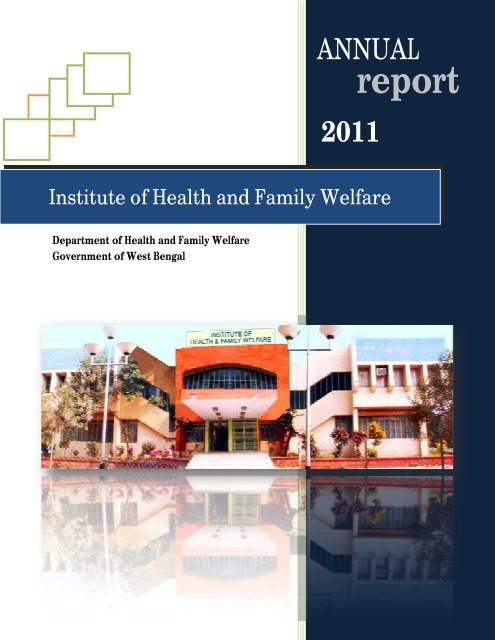
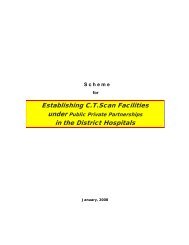
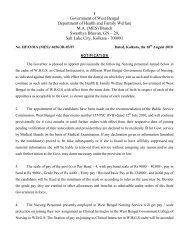
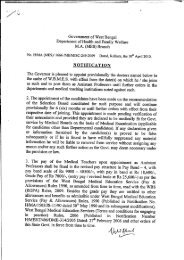

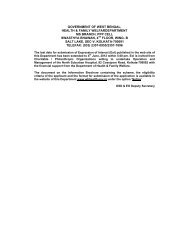
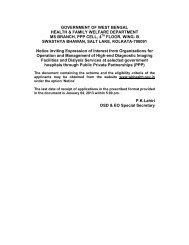
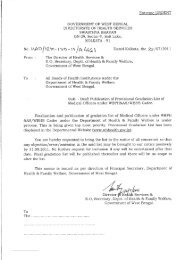
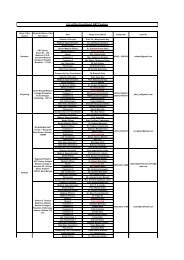
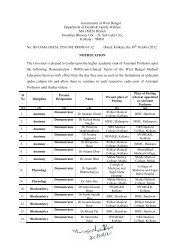
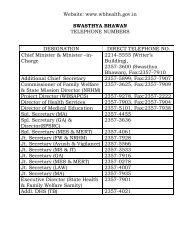
![supply of high end diagnostic equipments [digital radiography (dr)]](https://img.yumpu.com/45556814/1/190x245/supply-of-high-end-diagnostic-equipments-digital-radiography-dr.jpg?quality=85)
